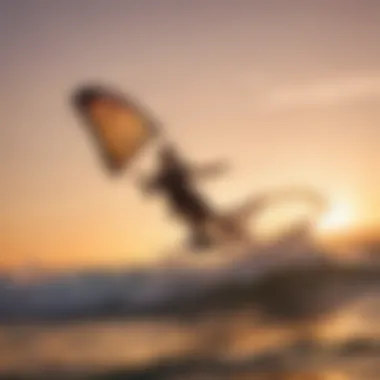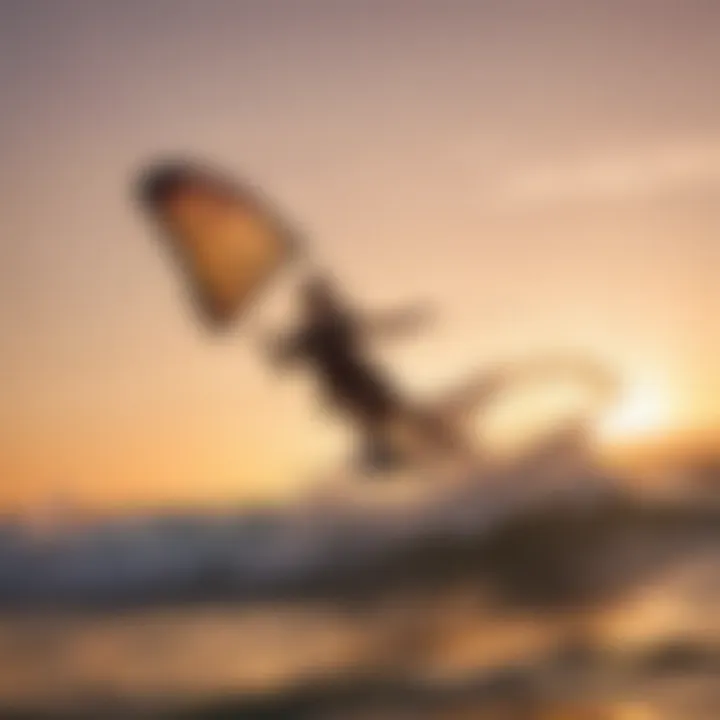Yoga Poses to Boost Watersport Performance


Intro
The world of watersports, from the exhilarating swells that surfers embrace to the tranquil paddles of paddleboarders and the adrenaline of kitesurfers, demands a high degree of flexibility, strength, and balance. These elements are crucial not just for performance but also for minimizing the risk of injury. Practicing yoga offers an effective approach to enhance these attributes. In this guide, we will delve into specific yoga poses that are beneficial specifically for those engaged in watersports. Our focus will be on integrating these poses into daily routines, making them as essential as one's gear.
Yoga is often perceived as a calm and meditative discipline, but at its core, it lays the groundwork for physical prowess and mental resilience. The postures we discuss aren’t just about stretching; they're tools to cultivate a deeper connection with one’s body. As we dive deeper, you’ll find sequences that cater to surfers looking to enhance their pop-ups, paddleboarders needing core stability, and kitesurfers aiming for better control in the air.
Gear Essentials
For any watersport, having the right gear is a given, but many enthusiasts overlook the importance of alignment and body awareness that yoga provides. This section will cover fundamental equipment essential for effective practice, alongside maintenance tips to keep that gear performing at its best.
Top Picks for Watersports Equipment
When it comes to watersports, the diversity of gear can sometimes feel overwhelming. However, a few standout items consistently enhance performance across all levels:
- Surfboard: Different types, like shortboards or longboards, cater to particular styles. Choose one that complements your skill level.
- Stand-Up Paddleboard (SUP): Look for a model that balances buoyancy and stability, especially if you're just starting out.
- Kitesurfing Gear: Focusing on the right kite and board size will impact your overall control, especially on varying wind conditions.
- Yoga Mat: While not a watersport item per se, it’s crucial for your practice. Choose one with good grip to facilitate smooth transitions between poses.
Maintenance and Care Tips for Gear
Maintaining your gear is essential to ensure longevity and performance. Here are some suggestions to keep your equipment in top shape:
- Surfboards: Rinse after every use to prevent swell from degrading the material. Store it out of direct sunlight to avoid fading and deterioration.
- Paddleboards: Clean the surfaces and check for any punctures regularly. A protective cover can extend its life.
- Kitesurfing Gear: Always pack your kite carefully and avoid letting it touch sharp objects. Replace lines if you notice any wear.
- Yoga Mat: Keep it clean by wiping down regularly and storing it rolled up to maintain its shape.
"Taking care of your gear is like taking care of your body; both will serve you better if you treat them well."
Techniques and Tips
Incorporating yoga into your watersport training not only enhances physical capabilities but also provides mental clarity. Let’s take a closer look at strategies for both beginners and advanced practitioners.
Beginner Tips for Each Watersport
Starting with some gentle tips will set a solid foundation:
- For Surfers: Focus on effective breathing techniques during your practice. Being calm helps when out on the waves.
- For Paddleboarders: Concentrate on core movements that improve balance. This will make those long paddles feel effortless.
- For Kitesurfers: Work on stability poses to get accustomed to shifting weights, particularly when the wind picks up.
Advanced Techniques for Skill Enhancement
As you progress, it’s important to challenge your body further:
- For Surfers: Integrate transitions between poses, mimicking the movements on a board, this enhances pop-up techniques.
- For Paddleboarders: Focus on dynamic stretches that incorporate arm movements, helping to improve your stroke technique.
- For Kitesurfers: Advanced balancing poses will help with agility and quick adjustments mid-flight.
In essence, the fusion of yoga with watersports creates a holistic approach to performance and wellbeing. In the sections that follow, we will explore specific poses and sequences tailored for your favorite activities, helping you glide through the waves with poise.
Prolusion to Yoga and Watersports
Yoga and watersports may seem like an unusual pair at first glance, finding their core connections requires just a bit of exploration. Watersport enthusiasts, including surfers, paddleboarders, and kitesurfers, constantly battle the elements; balance, strength, and flexibility are essential for mastering their sport. Adding yoga to your training routine can bring meaningful benefits that elevate performance and help prevent injuries. In this article, we'll dive into these connections and how incorporating basic yoga principles can enhance your watersport experience.
The Link Between Yoga and Watersports
The synergy between yoga and watersports is rooted in the disciplines’ shared requirements. Both demand a high degree of body awareness, breath control, and mental resilience. For instance, while navigating ocean waves, surfers rely on their balance and core strength to stay upright. Yoga, particularly asanas like Tree Pose or Downward Dog, helps hone these physical attributes.
Through yoga practice, watersport enthusiasts can cultivate a deeper connection not only to their bodies but also to their environment. Mindfulness, an integral part of yoga, encourages individuals to focus on their breath and movements — ideally suited for the unpredictable nature of water. This connection allows athletes to ride the waves with not only skill but also with a sense of peace and concentration, steering clear of distractions.
Benefits of Incorporating Yoga into Training
Engaging in yoga practices brings forth a plethora of benefits that seamlessly complement watersport activities. Here are several key advantages:
- Enhanced Flexibility: A core principle in yoga is flexibility, which is vital for injury prevention and overall performance. Tight muscles can hinder your movements, especially when maneuvering through waves or adjusting your stance on a paddleboard.
- Strength Building: Many yoga poses require the activation of various muscle groups, improving upper and lower body strength. This is essential for paddling and maneuvering with control during sport routines.
- Improved Balance: Yoga challenges your stability through various poses that focus on balance and coordination. This directly translates to better performance in watersports, allowing you to navigate turbulent water and turn swiftly.
- Mental Calmness: Watersports can be intense, often leaving participants feeling anxious. The meditative aspect of yoga fosters mental clarity and focus, helping athletes maintain composure during exhilarating or stressful moments on the water.
Through these points, it becomes clear that incorporating yoga offers tangible benefits. These advantages build a strong foundation for athletes striving for excellence in their respective watersports, leading to more enjoyable and successful experiences.
"Yoga teaches you how to listen to your body, which is essential for any watersport athlete."
In summary, yoga acts as a bridge connecting physical capabilities with mental strength, ultimately paving the way for improved performance in watersports. As we continue to explore key yoga principles that support this endeavor, it's essential to keep in mind the relevance of integrating these transformative practices into your regular training routine.
Key Yoga Principles for Performance
When it comes to enhancing performance in watersports, certain key yoga principles play a critical role. These principles are not just about physical movements; they intertwine with the mental and emotional aspects of practice. Understanding these elements can make a significant difference in how athletes approach their training and competition.


These principles enable athletes to tap into their full potential, ensuring they can operate at peak performance. By incorporating yoga into their routine, surfers, paddleboarders, and kitesurfers can not only build physical strength but also nurture the mental resilience needed for challenging environments. The seamless connection between mind and body is paramount here.
Understanding Breath Control
Breath control, or pranayama as it’s often referred, serves as the backbone of any yoga practice. For watersport enthusiasts, mastering breath control is invaluable. Take surfing, for instance. The rhythm of the waves demands that surfers time their movements perfectly, which includes being aware of when to hold their breath while riding a wave or when to inhale during a lull.
Key Points About Breath Control:
- Enhancing Oxygen Intake: Efficient breath control allows for maximum oxygen flow, crucial during physically intensive activities. This can impact endurance levels, allowing athletes to exert themselves longer without fatigue.
- Calming the Mind: Controlled breathing can act like a reset button for the mind. When faced with the unpredictable nature of watersports, maintaining composure is crucial.
- Aligning Body Mechanics: Syncing breath with movement helps in achieving equilibrium. Whether paddling or executing a turn on a wave, the coordination of breath and movement ensures optimal balance and precision.
Incorporating breath control practices into workouts isn’t just about doing yoga poses; it’s about understanding timing and rhythm.
The Role of Focus and Mindfulness
Focus and mindfulness are often overlooked yet crucial elements for athletes. In watersports, distractions abound—be it the roar of the surf, shifting winds, or the presence of spectators. Practicing mindfulness through yoga cultivates an ability to channel attention effectively, which can lead to improved performance.
The Importance of Focus and Mindfulness:
- Present-Moment Awareness: Engaging in yoga encourages practitioners to stay present. This is essential when timing a wave or adjusting the stance mid-paddle. It’s about being in the moment, without being clouded by past experiences or future outcomes.
- Enhanced Decision-Making: When athletes practice mindfulness, they become more attuned to their bodies and surroundings. This heightened awareness aids in making swift, informed decisions during high-pressure situations, like when to ride the crest of a wave.
- Stress Reduction: Watersport can be stress-inducing. Practicing focus and mindfulness helps in reducing that stress, allowing athletes to perform with a level head. It’s about going with the flow, both literally and figuratively.
"Mindfulness is the practice of being aware and fully immersed in the present moment. It can mean the difference between riding a wave beautifully and crashing into it."
Foundational Yoga Poses for Strength
In the world of watersports, where agility and strength are paramount, foundational yoga poses lay down the groundwork for enhanced performance. Muscles must not only be strong but also well-coordinated, supporting the body in dynamic movements that happen on the water. Incorporating these poses into your training routine can lead to improved stability, endurance, and injury prevention. The beauty of yoga is how it complements the physicality of watersports, providing a versatile approach to training.
Warrior Poses for Stability and Power
Warrior poses, such as Warrior I, II, and III, are essential in fortifying the legs and boosting overall body strength. These poses engage multiple muscle groups, ensuring that the core, arms, and legs work harmoniously together.
- Warrior I: Start in a standing position, step one foot back, and bend the front knee. Raise your arms overhead while sinking into the pose. This enhances flexibility in the hips while building strength in the legs.
- Warrior II: From Warrior I, turn the back foot parallel to the back of the mat and extend your arms out to the sides. The gaze follows the front hand, improving focus and stability. This pose strengthens the thighs and opens the hips, vital for balance on a surfboard or paddleboard.
- Warrior III: Transition from standing by balancing on one leg as the torso leans forward. Extend the opposite leg behind you and arms forward. It engages your core like nobody's business, perfect for all those tricky maneuvers on the water.
By practicing these warrior poses regularly, you cultivate not only physical strength but mental resilience as well. They train the body to stay grounded and prepared for sudden shifts in balance while practicing your favorite watersport.
Plank Variations for Core Strength
The plank is often touted as a powerhouse of core workouts. In the context of yoga, mastering plank variations can elevate your foundation of strength, which is critical for activities like surfing and kitesurfing that require a stable core. By integrating variations such as High Plank, Low Plank, and Side Plank, you enhance different muscle groups all while promoting a better sense of body awareness.
- High Plank: Start in a push-up position. Your body should form a straight line from head to heels. This position hones in on your shoulder strength, engages your core, and even activates your legs.
- Low Plank (Chaturanga): From the High Plank, lower to an elbow bend, keeping your elbows close to your sides. This, challenge the forearms and build strength in the chest.
- Side Plank: Rotate to one side, balancing on one hand or elbow. This is fantastic for oblique strength, helping you twist and maneuver more effectively when catching waves or controlling a wind-surf.
Integrating these plank variations into your routine builds a robust core that's tailor-fit for the demands of watersports. Having a solid core means less risk of injury and improved synchronization during action.
"Building strength through foundational yoga poses is like constructing a bridge; the sturdier the base, the higher you can soar."
These foundational moves are more than just physical exercises; they're a way to ground yourself, fostering a sense of balance that transcends the mat and flows out onto the water.
Enhancing Flexibility Through Yoga
Flexibility is not just a buzzword in the world of fitness; for watersport enthusiasts, it’s a crucial element in achieving peak performance. When you're balancing on a surfboard, maneuvering a paddleboard, or controlling a kite, having a body that can bend and stretch effectively makes all the difference. Engaging in yoga provides a pathway to improved flexibility, which in turn leads to greater agility and reduced injury risk during those high-stakes moments on the water.
Yoga poses specifically designed to enhance flexibility allow for better range of motion in the joints, promoting enhanced circulation and muscle recovery. This is particularly beneficial after those long hours spent riding the waves or paddling against the current. Moreover, flexibility aids in balance, a key component for conquering challenging waters. Therefore, integrating flexibility-enhancing routines not only complements physical training for surfing, paddleboarding, and kitesurfing, but it can also elevate the overall enjoyment and safety of participating in these exhilarating sports.
Pigeon Pose for Hip Openness
The Pigeon Pose is one of those yoga moves that many might initially overlook. But for watersport enthusiasts, its value is hard to beat. This pose targets the hip flexors and deep external rotators, making it essential for improving hip mobility. Open hips equate to smoother transitions and sharper turns, whether you’re riding waves or controlling your balance on a paddleboard.
To perform Pigeon Pose, follow these steps:
- Start in a tabletop position on your mat.
- Bring your right knee forward and place it behind your right wrist while extending the left leg straight back and keeping your hips square to the front.
- Inhale deeply, then lower your torso over your front leg.
- Hold this position, breathing into tight areas to release tension.
- Switch sides after holding for several breaths.
Regular practice of the Pigeon Pose will not only enhance your hip flexibility but also relieve tension often built from repetitive motion in watersports. The deep opening of the hips improves the body's overall performance, leading to more fluid motions and effective power generation while in the water.
Downward Dog for Spine and Shoulder Flexibility
The Downward Dog is a foundational position that serves multiple functions, one being the enhancement of shoulder and spinal flexibility. As many watersport activities require reaching, paddling, or even lifting the body into precarious positions, flexible shoulders and a strong spine become paramount.
Here’s how to get into Downward Dog:


- Begin on all fours, with your wrists directly under your shoulders and knees under your hips.
- Tuck your toes and lift your hips towards the ceiling, straightening your legs as much as possible.
- Press through your palms, allowing your shoulders to stretch and your back to lengthen.
- Keep your head between your arms, with your ears aligned with your upper arms.
- Hold for several breaths, focusing on expanding the spine and creating space in the shoulders.
This asana not only fosters flexibility but also supports strength in the core, allowing your body to stabilize during complex movements on the water. Over time, practicing Downward Dog welcomes a greater range of motion, thereby empowering you to paddle harder, turn quicker, and react faster, all of which are essential for excelling in watersports.
"Flexibility is the key to stability," and in the case of watersports, that stability can translate into better performance and reduced risk of injury.
By consistently embracing and integrating flexibility-enhancing yoga practices, watersport enthusiasts position themselves favorably for improved performance and enhanced enjoyment in their chosen activities.
Balance-Enhancing Yoga Asanas
When it comes to activities on the water, maintaining balance isn't just a nice-to-have; it's a must. For surfers, paddleboarders, and kitesurfers, the ability to stay upright, especially in challenging conditions, can make all the difference. This is where balance-enhancing yoga asanas come into play. These poses develop core strength, improve flexibility, and promote mental focus—all essential elements for performance in watersports.
With a steady foundation, a watersport enthusiast can ride a wave or navigate through choppy water with grace. Incorporating balance-centric yoga into training regimens not only heightens physical capabilities but also nurtures a mind-body connection that allows for better decision-making out on the water.
Tree Pose to Improve Stability
Tree Pose, or Vrksasana, is a widely recognized yoga position that significantly enhances stability. In this pose, you stand on one leg while bringing the opposite foot to rest against the inner thigh or calf of the standing leg. Arms can extend above your head, resembling the branches of a tree. The focus is on not just your physical balance, but also on your mental equilibrium.
- Benefits:
- Strengthens the legs, particularly the thighs, calves, and ankles.
- Enhances coordination and focus.
- Promotes a feeling of groundedness, essential when facing unpredictable elements while surfing or paddleboarding.
Practicing this pose regularly can help improve your ability to maintain position on a board, especially when encountering sudden shifts in direction due to waves or wind. As you progress, closing your eyes can add an extra layer of challenge, pushing your sense of balance further.
Eagle Pose for Coordination and Focus
Eagle Pose, or Garudasana, is another powerhouse for increasing coordination and focus. This asana requires you to wrap one leg around the other and then intertwine your arms, creating a stabilizing yet dynamic posture. The twisting nature of this pose not only helps in building strength but also encourages a heightened sense of awareness of your body's movements.
- Benefits:
- Strengthens the entire lower body while opening the shoulders and upper back.
- Challenges your balance, promoting agility needed in watersports.
- Provides mental clarity, sharpening your reflexes and decision-making process in high-pressure situations.
Incorporating Eagle Pose into your routine can mimic the coordination required when navigating through waves or adjusting your position while in motion. It helps create a kinesthetic awareness that can be invaluable when engaging in dynamic sports.
Practicing these balance-enhancing asanas not only fortifies your physical abilities but also cultivates the mental edge necessary for excelling in watersports.
In summary, incorporating Tree and Eagle poses into your training can vastly improve your stability and coordination. As the foundation for mastering watersport skills, these yoga moves can lead to enhanced performance, reduced risk of injury, and the confidence to push your limits.
Incorporating Yoga into Your Routine
In the fast-paced world of watersports, where every moment counts, incorporating yoga into your routine isn’t just a nice idea—it's a game changer. Whether you’re hanging ten on a surfboard, paddling across serene waters, or harnessing the power of the wind while kitesurfing, yoga serves as a vital tool to support your physical and mental game. The benefits range from enhanced flexibility and balance to improved focus and strength, making it essential for those serious about their performance.
Practicing yoga can significantly aid in prepping your body for the rigorous demands of your sport. With consistent practice, you’ll discover that your posture improves, which is crucial for maintaining stability on a board. Moreover, yoga helps to prevent injuries caused by repetitive movements that are commonly seen in watersports. As you move through various poses, you activate different muscle groups which develop essential strength, ultimately leading to better performance and less downtime due to injury.
Consider that integrating yoga isn’t merely an addition to your routine; it’s a way to deepen your connection to your body, enhancing proprioception—the awareness of one’s body in space. As you become attuned to your physical limits, you gain a clearer understanding of how to maneuver in challenging waters, which can make all the difference when it matters most.
Creating a Balanced Yoga Schedule
Establishing a balanced yoga schedule is key to maximizing its benefits for your watersport pursuits. Ideally, you should aim for a mix of strength-building and restorative sessions throughout the week.
- Frequency: Aim for at least three sessions per week. Even short fifteen to twenty-minute practices can enhance your performance.
- Duration: For each session, consider a blend of thirty-minute more intensive practices focused on strength or balance followed by slower, restorative poses aimed at recovery.
- Integration: Schedule yoga sessions around your training sessions. Allot time for a good stretch before and after a watersport activity to warm up your muscles and to cool down, making the most of your practice.
By spacing out your workouts and incorporating yoga into your training plan, you allow your body to recover while also strengthening it for more rigorous demands. As a result, this balance lays a solid foundation for optimal performance on the water.
Tips for Practicing Yoga at Home
Practicing yoga at home offers versatility and convenience for watersport enthusiasts. Below are some tips to create an effective home practice:
- Designate a Space: Find a quiet area where you can lay down a mat without distractions. The ambiance can play a significant role in your focus and relaxation.
- Use Online Resources: Leverage free or subscription-based online classes tailored for specific needs. Resources like YouTube or yoga apps can provide structure.
- Set Goals: Establish clear, personal goals. Whether it's achieving a difficult pose or committing to a certain number of sessions, having quantifiable goals keeps you motivated.
- Listen to Your Body: Be attentive to how your body feels. Adjust poses as needed to accommodate any physical limitations, especially after a long day on the water.
- Consistency is Key: Just like your surfing or kitesurfing practice, consistency is crucial. Even brief sessions add up over time, leading to substantial progress.
By incorporating these tips into your routine, you can create a home practice that not only complements your watersport activities but also feeds into the continuity of your physical and mental endurance on the water.
"Yoga is the journey of the self, through the self, to the self."
With these practices in place, you can maintain a rhythm that fosters strength, flexibility, and balance—characteristics that are invaluable to your success in watersports. Embracing yoga as part of your lifestyle leads to better performance and a more enriched experience on the water.


Yoga as a Recovery Tool
In the context of watersports, recovery is a fundamental element that often gets overlooked. The high intensity of activities like surfing, paddleboarding, and kitesurfing can lead to muscle fatigue, tension, and the risk of injuries. Yoga serves as an incredible recovery tool, acting as a bridge to help athletes not just recuperate physically but also mentally.
Importance of Restorative Poses
Restorative poses in yoga offer a gentle and supportive approach to recovery. These poses are designed to promote relaxation, aid in muscle recovery, and enhance flexibility without the strain that more vigorous asanas might impose. For someone who spends hours on the water, restorative poses can be like a balm for the body.
- Rejuvenation: Through deep stretching, restorative poses allow the body to release built-up tension. Poses such as Child’s Pose and Supported Bridge open up the front body and relieve stress from the lower back.
- Stress Reduction: Engaging in restorative yoga activates the parasympathetic nervous system, which counters stress. This biochemical shift not only aids in recovery but enhances overall mental clarity, essential for sharp focus during watersport activities.
- Improved Circulation: Restorative practices facilitate blood flow, which is crucial for delivering nutrients to fatigued muscles. Poses like Legs Up the Wall are particularly effective by promoting lymphatic drainage and reducing inflammation.
Practicing restorative yoga between sessions can keep your muscle health optimal, allowing you to hit the waves sooner and with greater comfort.
Guided Relaxation Techniques
Incorporating guided relaxation techniques into a post-training routine can elevate the recovery process to a whole new level. These practices are not just about lying down and unwinding; they involve structured methods tailored to release tension and restore energy levels.
- Body Scan: This technique involves focusing attention on different parts of the body, starting from your toes and moving upwards. As you mentally check in with each area, consciously relaxing any tightness helps develop greater body awareness.
- Breathwork: Using controlled breathing patterns, such as the 4-7-8 technique, can help calm the mind and stabilize the body’s stress response. Breath control is vital when you’re battling big waves, making it practical to adopt these practices into your routine.
- Visualization: Envisioning peaceful and serene environments, such as tranquil beaches or gentle waves, can be incredibly effective. This technique engages the mind and can facilitate a deeper state of relaxation.
To sum it up, utilizing yoga as a recovery tool not only nurtures the body but also cultivates mental resilience. By integrating these restorative and relaxation techniques into your training, you’re enhancing your performance while ensuring the longevity of your athletic endeavors.
Combining Yoga with Specific Watersports
When it comes to watersports, combining yoga with your activities isn’t just a nice addition; it’s often a game-changer. Surfers, paddleboarders, and kitesurfers can all benefit from the integration of yoga into their routines. This synergy helps to enhance physical performance, improve mental clarity, and reduce the risk of injuries.
Incorporating yoga allows athletes to develop greater awareness of their bodies, a crucial element when navigating the dynamic nature of water. The benefits are not just about strength and flexibility; it also overlaps into enhancing focus and relaxation, allowing for a more enjoyable experience on the water.
Yoga for Surfers: Tailored Practices
For surfers, yoga can help hone the skills necessary to ride the waves. Poses such as the Warrior series enhance lower body strength and stability, crucial for maintaining position as you balance on the board. Here are a few specific yoga practices tailored for surfers:
- Sun Salutations to increase heart rate and warm up before hitting the waves.
- Cobra Pose, which stretches the front of your body and opens up the chest, enhancing paddling efficiency.
- Bridge Pose strengthens the back, helping to maintain a strong posture while maneuvering on a surfboard.
Each session can start with some gentle stretches and flow into challenging poses that mirror the movements needed in surfing. This way, you’re building muscle memory that translates directly into improved performance out on the water.
Paddleboarding: Balance and Core Focus
Paddleboarding requires both balance and core strength, which are key components of yoga. Employing a consistent yoga routine can significantly aid in achieving better stability on the board. Here’s how specific yoga moves can help:
- Boat Pose teaches you how to engage your core effectively.
- Tree Pose enhances balance, allowing you to stand tall and firm as you paddle through the water.
- Downward-Facing Dog stretches the hamstrings and calves, keeping your body limber for agility while paddling.
Practicing these poses not only prepares the body but also calms the mind, creating a more focused approach to paddleboarding. Finding time for yoga before or after a session on the paddleboard can create a balance that elevates your overall experience.
Kitesurfing: Agility and Strength Development
For kitesurfers, agility and strength are often put to the test, especially during high winds and tough conditions. Yoga serves to refine body awareness and increase muscle strength. A tailored routine might include:
- Chair Pose, which builds quadriceps and enhances endurance.
- Plank Pose Variations to improve overall strength and stability, critical for controlling the board.
- Side Angle Pose to stretch the side body, which is essential for those twisting movements while kitesurfing.
The practice of these asanas, along with focusing on breath control, can help kitesurfers adapt to unexpected changes in the environment. This adaptability can result in a noticeable difference in your performance on the water.
Integrating yoga into your watersport practice is not merely an optional extra. It’s about crafting a toolkit of physical agility and mental fortitude that ripples through every wave you chase.
By immersing yourself in yoga tailored specifically for your preferred watersport, you build a bridge between land and sea. This fusion facilitates not just skill enhancement but also a deeper connection with the sport and its demands. Those who embrace this holistic approach may find more joy in their pursuits, resulting in a more fulfilled watersport experience.
Closure: The Path to Enhanced Performance
Incorporating yoga into the training regimen of watersport enthusiasts can significantly enhance performance across various dimensions—strength, flexibility, and balance. It’s not just about being able to stretch further or hold a pose longer; it’s about the subtle transformations that take place in the body and mind. As surfers, paddleboarders, or kitesurfers hone these essential skills through yoga, they often notice an immediate impact on their athletic journey.
Summary of Key Takeaways
For those invested in the world of watersports, several key elements emerge from our exploration of yoga:
- Enhanced Flexibility: The ability to twist and turn with ease can lead to better performance in catching waves, balancing on a board, or maneuvering in the air.
- Improved Core Strength: A strong core is critical for keeping balance while performing complex maneuvers. Poses like Planks and Boat pose will help build these muscles efficiently.
- Greater Focus: Concentration is vital, especially when out on the water where conditions can change in a heartbeat. Through mindfulness practices in yoga, one can cultivate an unshakeable focus.
- Reduced Injury Risk: The systematic stretching and strengthening of the body provided by consistent yoga practice mitigate the risk of injuries, allowing athletes to perform at their peak.
These points serve not only as highlights of what yoga can offer but also as encouragement for watersport enthusiasts to integrate these practices into their daily routines.
Encouragement to Integrate Yoga Practices
To truly reap the benefits of yoga, it should not remain on the periphery of the training plan but rather become a central component. Start small, perhaps with just fifteen minutes of daily practice. One could focus on foundational poses that target problem areas specific to their sport. For example, a surfer might prioritize hip openers like Pigeon Pose, while a kitesurfer might benefit from core-focused positions like the Boat Pose. Every little bit helps.
The key is consistency, not perfection. As you feel more comfortable, explore deeper into each pose and its variations, perhaps mixing different styles of yoga to keep the practice fresh and exciting. There are also various online resources available, including instructional videos on Reddit or community discussions on platforms like Facebook, where fellow enthusiasts share their experiences and tips.
In wrapping this up, remember that yoga isn't just about improving physical abilities. It cultivates mental resilience, fosters a deeper connection with the water, and ultimately leads to a more fulfilling experience in your chosen watersport. Embarking on this journey could well be the missing piece to unlocking your potential on the waves.



